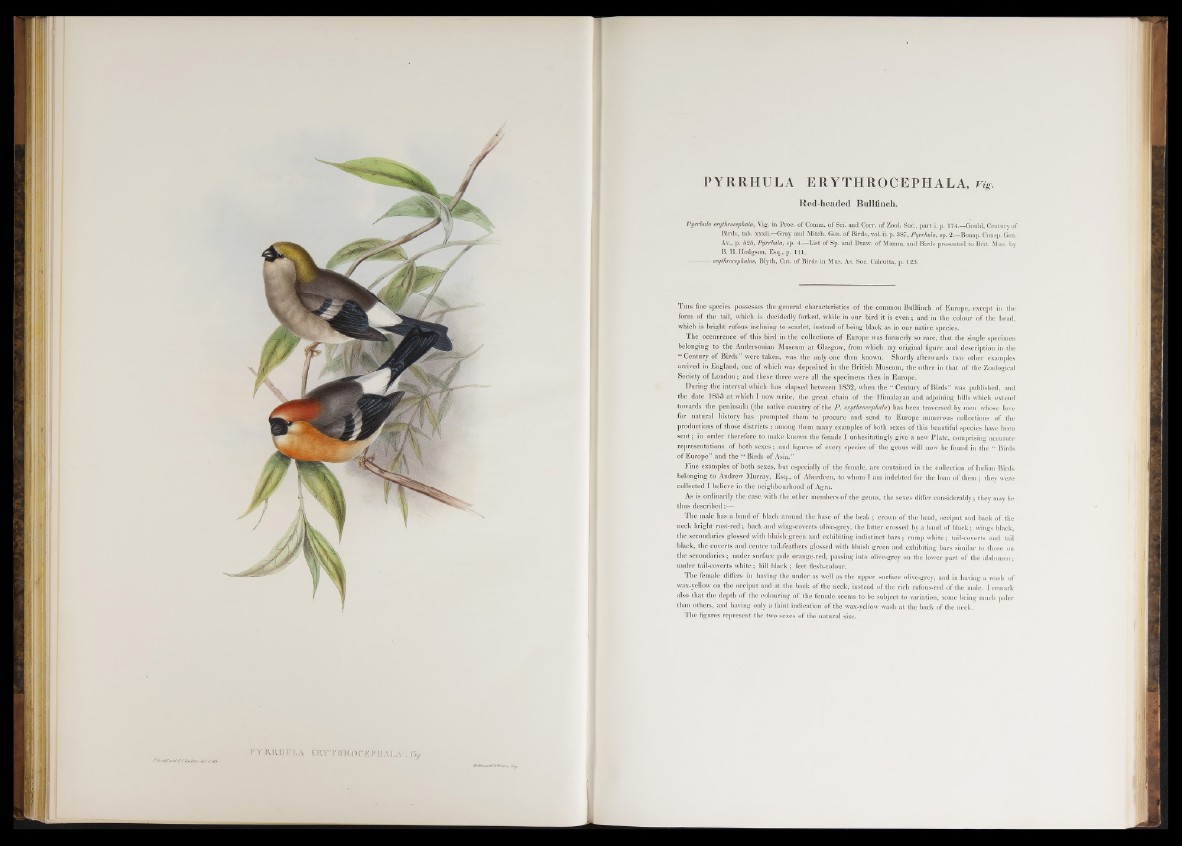
PYRRHULA ERYTHROCEPHALA, n s .
Red-headed Bullfinch.
Pyrrhula erythrocephala, Yig. in Proc. of Comm, o f Sei. and Corr. of Zool. Soc., p a r t i. p. 174.—Gould, Century of
Birds, tab. xxxii.—Gray and Mitch. Gen. o f B irds, vol. ii. p. 387, Pyrrhula, sp. 2 —Bonap. Consp. Gen.
Av., p. 525, Pyrrhula, sp. 4.—List of Sp. and Draw, o f Mamm. and Birds presented to Brit. Mus. by
B. H. Hodgson, Esq., p. 111.
erythrocephalm, Blyth, Cat. of B irds in Mus. As. Soc. Calcutta,, p. 123.
T h is fine species possesses the general characteristics o f the common Bullfinch of Europe, except in the
form of the tail, which is decidedly forked, while in our bird it is even; and in the colour of the head,
which is bright rufous inclining to scarlet, instead of being black as in our native species.
The occurrence o f this bird in the collections of Europe was formerly so rare, that the single specimen
belonging to the Andersonian Museum at Glasgow, from which my original figure and description in the
“ C entury o f Birds” were taken, was the only one then known. Shortly afterwards two other examples
arrived in England, one of which was deposited in the British Museum, the other in that of the Zoological
Society o f London; and these three were all the specimens then in Europe.
During the interval which has elapsed between 1832, when the “ Century o f Birds” was published, and
the date 1853 a t which I now write, the great chain of the Himalayan and adjoining hills which extend
towards the peninsula (the native country of the P . erythrocephala) has been traversed by men whose love
for natural history has prompted them to procure and send to Europe numerous collections of the
productions of those districts ; among them many examples of both sexes of this beautiful species have been
sen t; in order therefore to make known the female I unhesitatingly give a new Plate, comprising accurate
representations o f both sexes; and figures of every species of the genus will now be found in the “ Birds
o f Europe” and the “ Birds of Asia.”
Fine examples of both sexes, but especially o f the female, are contained in the collection of Indian Birds
belonging to Andrew Murray, Esq., of Aberdeen, to whom I am indebted for the loan of th em ; they were
collected I believe in the neighbourhood o f Agra.
As is ordinarily the case with the other members of the genus, the sexes differ considerably; they may be
thus d e scrib ed |= 9B 0
The male has a band of black around the base of the b eak ; crown of the head, occiput and back of the
neck bright ru st-red ; back and wing-coverts olive-grey, the latter crossed by a band of black; wings black,
the secondaries glossed with bluish green and exhibiting indistinct b a rs; rump white; tail-coverts and tail
black, the coverts and centre tail-feathers glossed with bluish green and exhibiting bars similar to those on
the secondaries; under surface pale orange-red, passing into olive-grey on the lower part of the abdomen;
under tail-coverts white; bill black ; feet flesh-colour.
The female differs in having the under as well as the upper surface olive-grey, and in having a wash of
wax-yellow on the occiput and at the back of the neck, instead of the rich rufous-red of the male. I remark
also that the depth of the colouring o f the female seems to be subject to variation, some being much paler
than others, and having only a faint indication o f the wax-yellow wash at the back of the neck.
The figures represent the two sexes of the natural size.